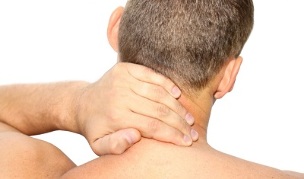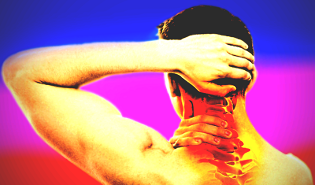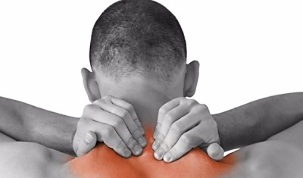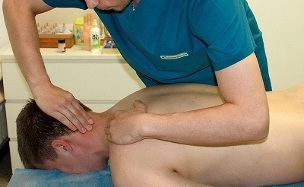Cervical osteochondrosis is a common disease accompanied by degenerative changes and dystrophy in the spine. The symptoms of the disease in men and women are the same. Treatment is prescribed by a doctor depending on the severity of the lesion and the patient's condition.
Symptoms of osteochondrosis in men
The main symptom of cervical osteochondrosis is pain. There are a number of additional signs that will help determine the presence of degenerative spinal lesions in the cervical spine.
Pain occurs against a background of disturbances in the peripheral area, this is the result of adverse effects on nerve roots and adhesions that connect tissues, discs and muscles. With cervical osteochondrosis, men experience periodic or persistent pain. In the morning, the patient may feel pain in the neck.
Important!Unpleasant sensations occur with head rotation, coughing and sneezing.
Due to strong muscle tension, a man cannot breathe deeply. The pain may radiate to the occipital part of the head, this indicates an lesion of the occipital nerve.

While pounding the upper cervical vertebra, a man may feel a painful lump. When nerve root compensation occurs, discomfort can radiate to the shoulder and arm areas.
Cervical osteochondrosis is characterized by degenerative processes in the intervertebral disc.
Decreased blood circulation in nerve nodes leads to the following symptoms:
- excruciating pain in the back of the head;
- numb hands at night;
- swollen hands;
- irregular heartbeat;
- itching and itching when turning the head.
Vascular signs appear when the brain stem is affected. Cervical osteochondrosis interferes with normal blood flow in the vertebral arteries. Against the background of such pathological changes, neurotic failure occurs:
- insomnia;
- nonsensical irritation;
- walks shaky;
- dizziness;
- rapid heartbeat;
- excessive sweating;
- memory impairment.
In some cases, the performance of visual tools is deteriorating. The danger of osteochondrosis is that it provokes the development of the following syndrome:
- Stenosis. This is a narrowing of the spinal canal, when the brain canal is squeezed by a herniated intervertebral disc. The upper and lower limbs begin to numb.
- Reflex-annoying. This syndrome is accompanied by burning pain in the back of the head.
- Radicular. With this pathology, the nerve root is compressed by the intervertebral disc. The pain was excruciating, burning and throbbing.
In most cases, the symptoms of osteochondrosis in men are almost the same as in women. When the first pain attack occurs, patients do not always suspect that it is cervical osteochondrosis. Timely diagnosis will help prevent complications.
Diagnosis of cervical osteochondrosis
X-rays are taken to diagnose the disease. This will help ensure no spinal injuries. However, this research method does not provide an opportunity to look at osteophytes. For this, more modern diagnostic methods are used.

Performs assigned tasks:
- computed tomography;
- magnetic tomography;
- neck ultrasound scan.
Computed tomography involves the creation of an X-ray network showing the number of cervical vertebrae. Such details make it possible to assess the nature of nerve compression, disc height and osteophyte structure.
Magnetic resonance imaging is considered one of the most informative diagnostic methods. It allows you to assess the state of bone structure. During an MRI, the doctor may detect the presence of a hernia.
Duplex vascular scans are used if doctors suspect bleeding disorders in the vertebral arteries.
Treatment of male osteochondrosis
The treatment chosen depends on the degree of damage and the general well-being of the man. In most cases, medication and physical therapy are recommended.
HELP.Conservative therapy aims to relieve pain and relieve muscle cramps.
Physiotherapy activates the regrowth process in cartilage tissue. Such a procedure can be part of a comprehensive treatment or an independent method.
The following procedure is set:
- Electotherapy.The effect on the affected spinal area is through electric current. This manipulation activates blood circulation. Contraindications include the presence of pacemakers or metal parts in the patient's body.
- Magnetotherapy.This method involves exposure to a fixed magnetic field. One procedure lasts for 20 minutes.
- Laser therapy.It uses a helium-neon laser. They enhance the bioelectric processes in the tissues of the nervous system. It has anti-inflammatory, analgesic and wound healing effects. The duration of exposure to one area does not exceed 2 minutes, the whole procedure takes about 14 minutes.
- Shock wave therapy.This type of exposure is rarely used, as there is much controversy about its effectiveness. Impact is given through acoustic waves. They help increase metabolism and activate blood circulation in the blood.
- Balneotherapy.Treatment is done with mineral water and mud therapy. All beneficial substances penetrate the skin and act on receptors and nerve endings.
To restore the mobility of the affected area, gymnastic exercises should be performed. They will help strengthen the muscular corset and make the ligaments more flexible. The first training should be done under the supervision of the trainee, as it is not the training that is done that is important, but their technique.
Important!Surgical intervention is indicated if medical treatment and physiotherapy do not bring the desired results.

This is called cervical dysectomy. The doctor paralyzes the affected segment and removes the hernia, which puts pressure on the spinal cord. Over time, the vertebrae grow together. 3-5 days after surgery, the patient is transferred to an outpatient clinic.
The recovery period is about 3 months. The exact recovery time depends on the implant and the professional activity of the patient being operated on.
However, it is advisable to start treatment of cervical osteochondrosis with a visit to the doctor. Self-treatment can worsen the course of the disease and cause surgery.
Medication for treatment
Medication for osteochondrosis can only be taken as directed by a doctor. He creates a therapeutic regimen and chooses the optimal dose.
The following groups of drugs are prescribed:
- analgesics;
- antispasmodik;
- anti-inflammatory drugs;
- vasodilator;
- chondroprotectors.
HELP.The active ingredient not only relieves cramps, but also reduces the sensitivity of nerve endings.
Your doctor may prescribe the use of non-steroidal anti-inflammatory drugs. These medications relieve pain and reduce inflammation.
It is best to use medication to reduce blood viscosity as a vasodilator. They improve blood circulation. Taking such a drug encourages rapid recovery after treatment of cervical osteochondrosis.
The action of chondroprotectors aims to activate the regeneration process in injured cartilage.

Improperly selected treatment can lead to the formation of a herniated disc. With cervical osteochondrosis, hypertension often occurs. If necessary, the doctor prescribes medication to relieve the symptoms of such pathological conditions.
For drug treatment to be as effective as possible, it must be combined with medical gymnastics and physiotherapy procedures.
After the chiropractic session, try not to grip your neck. The muscles after the procedure will be relaxed to the maximum and you can reduce the positive effects of the session.
Nutrition for osteochondrosis
With osteochondrosis, a man should pay special attention to his diet. It must be balanced, because the body must get adequate amounts of vitamins and nutrients.
The following foods should be in the diet:
- vegetables and herbs;
- berries and fruits;
- dairy products and fermented milk;
- protein-rich foods;
- foods that contain gelatin and collagen.
Plant foods are rich in vitamins and fiber. They have little energy value, which contributes to the maintenance of normal weight. Parsley, cauliflower, beets, and broccoli are very useful.
For patients with osteochondrosis, it is recommended to include sea buckthorn in the diet. Based on fruits and berries, you can prepare jelly. Fermented milk products contain large amounts of calcium, vitamin D and phosphorus. These vitamins and nutrients strengthen bones and cartilage tissue.
The following products must be in the daily menu:
- fermented roasted milk;
- cheese without preservatives;
- yogurt;
- curdled milk.
It is important that dairy and fermentation products are natural, free of dyes and other harmful additives. Protein is very important for the formation of bone and cartilage tissue. Most are found in eggs, milk, grains and brewer's yeast.
Fish and seafood will benefit. They contain double fatty acids and unsaturated fats, which are necessary for the body's normal recovery. Collagen is found in jelly, aspic and aspic fish. It stimulates the synthesis of cartilage tissue.
HELP.It is best to replace regular vegetable oil with extra virgin olive oil. It is important to maintain water balance.
Use only filtered water or bottles.
Most men see a doctor when osteochondrosis is at an advanced stage. There are a number of symptoms that indicate the development of pathological conditions. Timely diagnosis and treatment will help prevent surgery and complications.



































